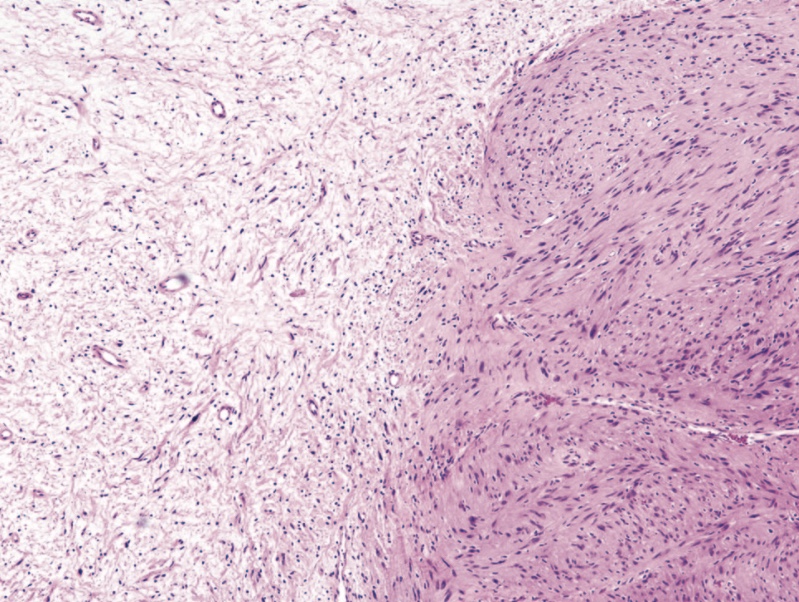Acoustic neuroma pathophysiology
|
Acoustic neuroma Microchapters | |
|
Diagnosis | |
|---|---|
|
Treatment | |
|
Case Studies | |
|
Acoustic neuroma pathophysiology On the Web | |
|
American Roentgen Ray Society Images of Acoustic neuroma pathophysiology | |
|
Risk calculators and risk factors for Acoustic neuroma pathophysiology | |
Editor-In-Chief: C. Michael Gibson, M.S., M.D. [1]Associate Editor(s)-in-Chief: Simrat Sarai, M.D. [2] Mohsen Basiri M.D.
Overview
Acoustic neuroma arises from Schwann cells, which are the cells involved in the conduction of nervous impulses along axons, nerve development and regeneration. On microscopic histopathological analysis, acoustic neuroma may display two types of growth patterns: Antoni type A and Antoni type B. Antoni type A growth pattern is composed of elongated cells with cytoplasmic processes arranged in fascicles, little stromal matrix and verocay bodies. Antoni type B growth pattern is composed of loose meshwork of cells, less dense cellular matrix, microcysts and myxoid change.
Pathophysiology
- Acoustic neuromas are benign tumors (WHO grade 1), usually arising from the intracanalicular segment of the vestibular portion of the vestibulocochlear nerve (CN VIII), near the transition point between glial and Schwann cells (Obersteiner-Redlich zone).
- An acoustic neuroma arises from a type of cell known as the Schwann cell. These cells form an insulating layer over all nerves of the peripheral nervous system (i.e., nerves outside of the central nervous system) including the eighth cranial nerve.
- Most acoustic neuromas are found along the vestibular portion of the eighth cranial nerve.
- As these tumors are made up of Schwann cells, and usually located along the vestibular portion of the eighth cranial nerve, many physicians prefer to use the term, "vestibular schwannoma". However, the term acoustic neuroma is still used more often in the medical literature.[1]
- Acoustic neuromas are well circumscribed encapsulated masses, which unlike neuromas, arise from but are separate from nerve fibers.
Genetic
- One the most common causes of acoustic neuroma is neurofibromatosis type 2 (NF2), an autosomal dominant disease caused by loss of function mutation.
Associated Conditions
- Acoustic neuroma is strongly associated with neurofibromatosis type 2 (NF2).[2]
Microscopic Pathology
- In 1920, Nils Ragnar Euge`ne Antoni (1887–1968), a Swedish neurologist and researcher described 2 distinct patterns of cellular architecture in the peripheral nerve sheath tumors, based his observations on analysis of 30 cases and described a “fibrillary, intensely polar, elongated appearing tissue type” which he called “tissue type A.” [3]
- These highly cellular regions were eventually referred to as Antoni A regions by later authors. [3]
- Antoni also described seemingly distinct loose microcystic tissue adjacent to the Antoni A regions, and these came to be known as Antoni B regions.[3]
They can display two types of growth patterns:[3]
- Antoni A
- Elongated cells with cytoplasmic processes arranged in fascicles
- Little stromal matrix
- Verocay bodies: nuclear free zones of processes lying between regions of nuclear palisading
- Antoni B
- Loose meshwork of cells
- Less densely cellular
- Microcysts and myxoid change
- Photomicrograph of Antoni A tissue and Antoni B tissue within a schwannoma. The highly cellular Antoni A region on the right of the field is contrasted with the loosely organized hypocellular Antoni B region on left of the field (hematoxylin-eosin, original magnification 400).

References
- ↑ Acoustic Schwannoma. Radiopedia(2015) http://radiopaedia.org/articles/acoustic-schwannoma Accessed on October 2 2015
- ↑ M. M. Eibl, R. Ahmad, H. M. Wolf, Y. Linnau, E. Gotz & J. W. Mannhalter (1987). "A component of factor VIII preparations which can be separated from factor VIII activity down modulates human monocyte functions". Blood. 69 (4): 1153–1160. PMID 3030465. Unknown parameter
|month=ignored (help) - ↑ 3.0 3.1 3.2 3.3 Wippold II, F.J (2007). "Neuropathology for the Neuroradiologist: Antoni A and Antoni B Tissue Patterns". AJNR Am J Neuroradiol.